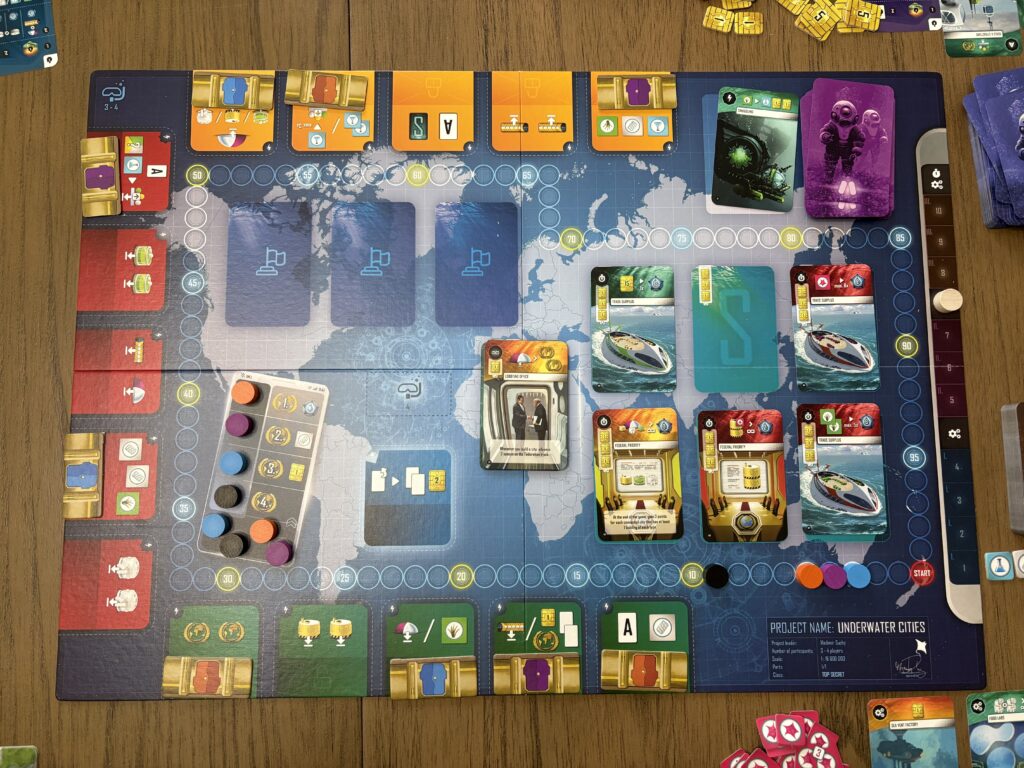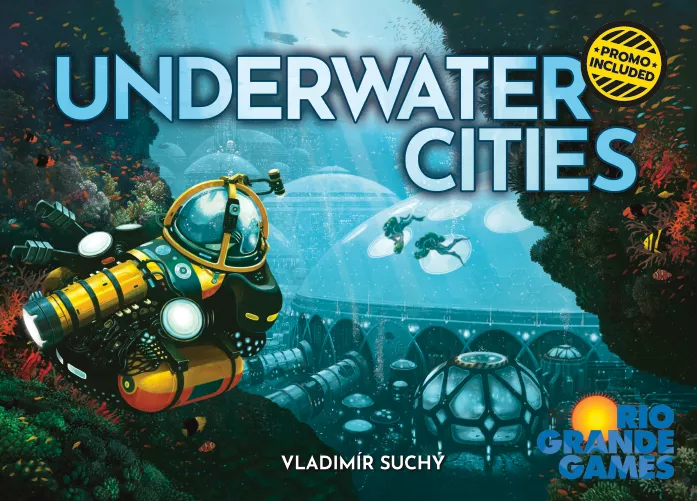Welcome to this week’s review! This week I’m discussing Vladimir Suchý’s arguably most popular game which I recently did an unboxing for here. So without further ado, let’s jump into my thoughts.
Disclosure: A review copy of this game was provided to The Meeple Digest in exchange for an honest, unbiased review. This review is not intended to be an endorsement.
Underwater Cities
- Designer: Vladimir Suchý
- Publisher: Rio Grande Games, Delicious Games
- Complexity: Medium
- Time: 80-150 Minutes
- Players: 1-4
- Main Mechanisms: Worker Placement, Hand Management
Underwater Cities is worker/card placement game where players build out a network of underwater structures consisting of domed cities, tunnels, and production buildings. The game is played over the course of three eras, each consisting of three or four rounds. During a round, players take turns placing each of their three action tiles onto actions on the main board, along with a card from their hand. At the end of each era, all players produce goods and points from their network of buildings and tunnels on their individual player board, and the deck of cards is replaced with ones from the next era. After three eras, the game proceeds to final scoring where players will gain additional points based on their end-game scoring cards, tiles, network of cities and buildings, as well as left over resources. And of course, the player with the most points at the end of the game wins.

My favorite part of Underwater Cities is the worker and card placement mechanic. Worker placement is a heavily used mechanism, but Underwater Cities adds a unique twist with its cards. Whenever a player places one of their action tiles down, the player also has to play a card from their hand. If the color of the card matches the action space, then the player gets the benefit of their played card. However, if the colors differ, then the player only gets to trigger the action on the board. There are three different colors of actions, and what’s interesting is that the colors have different power levels. For example, the green cards are the strongest, but green actions on the board are the weakest. In contrast, the yellow cards are the weakest, but the yellow board actions are the strongest. Each player also only has a hand of three cards, so it creates an interesting dynamic where players are forced to consider whether it’s worth taking an action just for the benefit of the card or action space.
The game also does an excellent job of feeling tight enough without being too restrictive. Especially at four players, I found myself constantly keeping track of the turn order track because turn order and action spaces only reset at the end of the round (after each player has played three actions), and going late in turn order can be especially challenging. There’s nothing quite like forming a well-laid plan only for it to go out the window when the player in front of you in turn order takes the action space you really needed. One downside to this, however, is that since players’ hands are kept secret, it is often difficult to anticipate where other players are going to go, and most of the player interaction comes down to jostling for turn order.
When players build a new city, building, or tunnel, they get to place the piece on their player board. This makes the actual task of building out a network feel incredibly satisfying. At the beginning of the game, each player only starts out with a few resources and a single city. However, by the end of the game, it’s fun to look back at the underwater civilization you’ve developed.
It is worth noting that while the theme of building out underwater cities is captivating, the game isn’t exactly dripping with theme, and I found that the game felt more mechanical than thematic. This isn’t necessarily an issue for me – just be prepared to not get lost in its theme.
Another interesting mechanism are the special cards that players can claim throughout the game. The special cards work very similarly to regular cards in the game, but they will often provide “special” effects or end-game scoring opportunities to the player who claimed them. At the beginning of each game, six three-credit special cards are randomly chosen, and there is also a deck of one and two-credit cards. More experienced players will likely use the three-credit special cards to guide their early strategy as claiming them can provide a large number of points at the end of the game if maximized. However, since special cards also count towards a player’s hand limit, it’s often not ideal to grab one too early if you don’t plan on playing it right away. Therefore, this creates an interesting timing consideration. Do I claim the one I really want early and guarantee I get it, or wait and run the risk that another player claims it?

I already mentioned that player order is especially important with four players; however, this leads to some weirdness around the player scaling. There are two sides of the board: one for up to two players and the other for three and four. The three and four player side of the board has more slightly different action spaces and more of them, but I found that with four players, some actions felt more impactful than with only two player. For example, turn order is dictated by a player’s position on the Federation track and is reset at the beginning of each round. There is one action that allows players to advance on that track, which I found myself often using in my four-player game, but I rarely used it with only two players. In addition, since the same number of actions are available with both three and four players, the four player play felt tighter than other plays while also being noticeably longer. These aren’t necessarily negatives, rather it simply made the player scaling feel a bit odd.
As with most games with a deck of cards, there is bound to be some card draw luck involved. Since players are encouraged to play matching colored cards with their action, there can be scenarios where the cards in your hand just don’t line up with the available actions or you keep drawing the same color card. Some actions do provide opportunities to draw more cards, but you’re still only limited to only three cards in your hand (unless you get a card that increases your hand size). Overall, I didn’t find this element of luck to be that swingy, but it’s worth noting for those who are wary of card draw luck.
Another small issue I have with the game is that the iconography is not always the most clear and some of the artwork feels like something out of a prototype. The iconography and tokens for the resources gets the job done, but I wouldn’t have minded something a bit nicer to look at. For example, the icon for drawing more cards is just a white rectangle. The rulebook is relatively easy to understand for the most part, but I found it challenging to reference if I just wanted to check a specific rule.
Finally, while I’ve heard the discussions around the game feeling unbalanced, and I certainly haven’t played the game enough times to form a definitive opinion, based on my handful of plays, I found that some strategies did feel easier to pull off than others. In my first game of Underwater Cities, I happened into a big kelp strategy based on a few early cards that gave benefits for having a bunch of upgraded kelp farms. I was able to combine this with a couple of special cards that rewarded farms and kelp at the end of the game. I was still able to win the game even though I never connected my brown metropolis and had the fewest cities. I’m not saying that a bunch of kelp farms is definitively stronger than the other types of buildings, but if you manage to get two upgraded farms in your cities early, the extra points from farms can really add up. Add already needing kelp to feed your cities, and the strategy becomes pretty strong. Can you still win the game using other strategies? Of course. It just felt that a strategy around upgraded kelp farms was easier to do well in.
Even with these slight nitpicks, I’ve really enjoyed my time so far with Underwater Cities. The worker placement and card mechanics are incredibly engaging, and I had fun building out a settlement of underwater structures. While I wish there had been a few changes to player scaling and upgraded visuals for the components and art, that doesn’t hold Underwater Cities back from being in the running for my favorite Vladimir Suchý design. I’m looking forward to diving back into Underwater Cities in the New Discoveries expansion for the game, so stay tuned for a full review of that expansion coming soon.
With that, I’ll wrap up this week’s review! I’d love to hear your thoughts on any of the games I’ve mentioned or future content suggestions in the comments below. Happy gaming!
If you liked this post and want to be notified when new content is released, then follow me on Instagram @themeepledigest.
